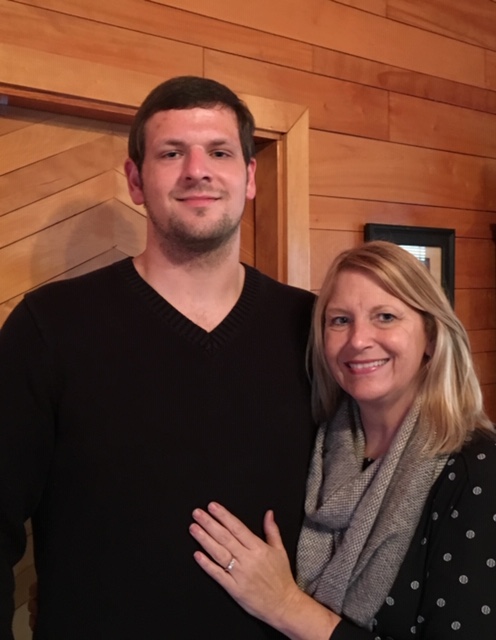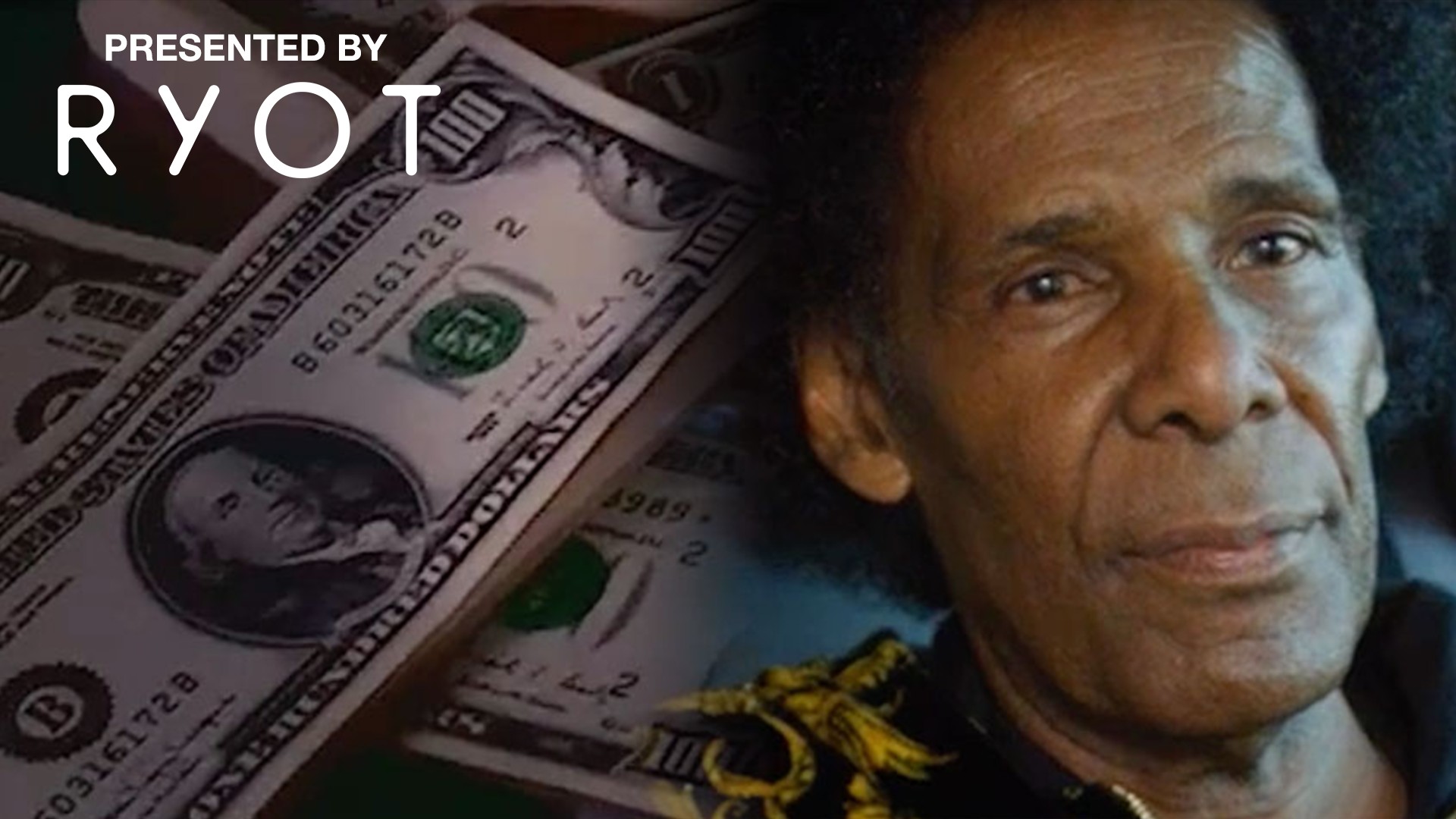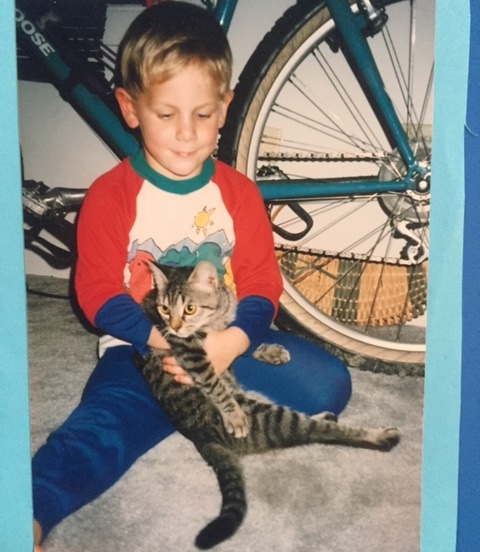Jeremy Beal woke up on the floor of a friend’s house in November 2017. Fifteen minutes earlier, he’d been dying from an overdose. The 25-year-old from Maine had stopped breathing for 12 minutes after overdosing on heroin.Recalling the evening, Beal said he’d used a small amount of heroin while drinking alcohol. It was enough to cause an overdose, perhaps because he hadn't been using for a few weeks before that. A friend revived him with two hits of Narcan, the nasal spray that reverses the effects of a drug overdose.
Advertisement
Then the cops came in. Beal was taken to the hospital, checked out, and promptly arrested in his bed for unpaid fines. Within two hours of nearly dying, he was handcuffed and taken to the police station to spend the night in jail.

The episode was one of a long line of unfortunate interactions Beal had with the criminal justice system in Maine during his six years as an opioid user. While trying to deal with his addiction, he was arrested four times, placed in solitary confinement, and caught up in a Maine Drug Enforcement Agency (DEA) investigation. He tried to address his addiction, twice seeking assistance from rehabilitation programs.A series of interviews with Beal and those close to him highlighted the everyday reality for many of America’s almost three million people struggling with prescription and street opioid misuse. Crucially, the evidence suggests Beal’s experiences are not extraordinary, even if his status as a white man with decent access to resources via his family and community may have spared him an even more onerous saga. Which makes the whole thing all the more pernicious: Even after all the media coverage, attempts by law enforcement officials and healthcare professionals to fight the opioid crisis continue to reinforce the very problems they are meant to address.

The episode was one of a long line of unfortunate interactions Beal had with the criminal justice system in Maine during his six years as an opioid user. While trying to deal with his addiction, he was arrested four times, placed in solitary confinement, and caught up in a Maine Drug Enforcement Agency (DEA) investigation. He tried to address his addiction, twice seeking assistance from rehabilitation programs.A series of interviews with Beal and those close to him highlighted the everyday reality for many of America’s almost three million people struggling with prescription and street opioid misuse. Crucially, the evidence suggests Beal’s experiences are not extraordinary, even if his status as a white man with decent access to resources via his family and community may have spared him an even more onerous saga. Which makes the whole thing all the more pernicious: Even after all the media coverage, attempts by law enforcement officials and healthcare professionals to fight the opioid crisis continue to reinforce the very problems they are meant to address.

Beal's addiction began about six years earlier, when he was 19. After a fraught start to college, failing out of one and completing only one semester at another, he found himself working as a bar back in Charlotte, North Carolina. While partying with co-workers, Beal fell on a broken glass and cut his hand.
Advertisement
“The next day, it was still hurting really bad,” he recalled. “I went to an urgent care place. It was really swollen and stuff.” A doctor prescribed him the opioid OxyContin to handle the pain. “That’s when I first realized that I liked narcotics,” he said.
His first brush with the criminal justice system actually wouldn’t directly involve drugs, though he’d started using Xanax and Vicodin regularly: He used bolt cutters to break into lockers at a Planet Fitness, and stole $500 and a credit card. He said this was an effort to pay his rent; Beal used the card to buy four pairs of sneakers. After a store camera caught the purchase, he was charged with a felony.He was able to settle the charges as misdemeanor theft, and moved up to Maine to live and work with his mother and stepfather. He got a job at a car wash that paid $9 an hour. “This is when I really got back into pills again,” he said.In Maine, opioid deaths climbed sharply from 2012 to 2017, with steep increases most of those years, according to data from the office of the state’s Attorney General. The numbers might not seem all that remarkable in the abstract—in 2017, Maine saw 418 deaths from overdoses. But the state’s rate of opioid-related overdose deaths was twice the national average, according to the National Institutes of Health.“Every night I was going out and committing crimes, making sure I had enough money to pay for my habit."—Jeremy Beal
Advertisement
The opioid epidemic dramatically accelerated in recent years, in the state and nationally (though preliminary numbers suggested OD deaths may have ticked down in Maine last year). In an average day, according to data from the Centers for Disease Control (CDC) and Prevention, 146 people die due to opioid overdoses in the United States—accounting for approximately two-thirds of all drug overdoses.Approximately a third of Maine’s opioid deaths in 2017 involved attempts to reverse the overdose with naloxone—the generic form of Narcan and a substance that blocks opioid receptors—only for it to be administered too late. Maine’s just-departed, two-term Republican governor, Paul LePage, repeatedly blocked attempts to make Narcan widely available. For eight years, he instead favored a heavy-handed approach to law enforcement that critics say helped perpetuate cycles of addiction for young people like Beal. In 2014, a sheriff-turned-lawmaker from Portland, Mark Dion, told the Boston Globe that LePage’s enforcement approach to drug addiction was “spinning the merry-go-round faster and faster.”Two years later, the governor remained steadfast in his approach.“Naloxone does not truly save lives; it merely extends them until the next overdose,” LePage wrote when he vetoed a 2016 effort by the state legislature to make Narcan available to all citizens.
Working at the car wash, Beal started buying Oxycontin from a co-worker. Pretty soon, he’d left that job and was living out of hotel rooms with a girlfriend. As his drug habit took a stronger hold, he began stealing money to buy pills.
Working at the car wash, Beal started buying Oxycontin from a co-worker. Pretty soon, he’d left that job and was living out of hotel rooms with a girlfriend. As his drug habit took a stronger hold, he began stealing money to buy pills.
Advertisement
“Every night I was going out and committing crimes, making sure I had enough money to pay for my habit,” he said, “and to pay for the hotel room, and to pay for me and my girlfriend to eat, and take her daughter to Chuck E. Cheese.”Those crimes were primarily petty theft, he said, and he does not appear to have ever been caught, at least at this stage of his addiction. Walking the street, he would check for unlocked cars or open garages. This went on for eight months, he recalled, until he got into a fight with his girlfriend and drove under the influence. He got into an accident that popped two of his tires.“I called my mom, and then I just told her: ‘I’m addicted to opioids,’” he said. At this point, he said, he was only using pills.His mother picked him up, and he tried to detox at her house that night. Shortly afterward, she helped him sign up for treatment at Mercy Recovery Center, a facility that would be closed within a few years due to financial problems. His treatment through that program required he remain at the rehab center for six hours each day for 28 days.

After one day of full detox, doctors prescribed him Suboxone, a commonly used form of buprenorphine that can replace stronger opioids like heroin and also includes naloxone. Users can still get high, but they almost never overdose. For a little more than one year, he would check in at the facility each week and pick up his prescription.

After one day of full detox, doctors prescribed him Suboxone, a commonly used form of buprenorphine that can replace stronger opioids like heroin and also includes naloxone. Users can still get high, but they almost never overdose. For a little more than one year, he would check in at the facility each week and pick up his prescription.
Advertisement
Medically-assisted treatment with methadone or Suboxone, like Beal’s, remains a source of debate among recovery advocates in the United States. Some working in the field feel abstinence programs are safer because they don’t carry the risk of simply replacing one drug with another. Scientific research, however, has shown that medically-assisted recovery programs cut the death rate at least in half. But even if the positives of this practice are well documented, Beal’s treatment instead seemed to help accelerate his addiction.For months, he was committed to his recovery, but eventually that started to unravel. He met a woman in the rehab clinic, and moved in with her. He began using Suboxone outside of his regular treatment, all while attending the sessions at Mercy.He decided to use heroin with her and some friends. One day, she told him she didn’t care if heroin killed her, a moment he remembered as a wake-up call. He began seeing another woman who was using Suboxone. For months, both relationships were off and on.In 2014, he sold heroin to a person that turned out to be a Maine Drug Enforcement Agency (DEA) informant. They texted Beal to set up the buy, and multiple agents watched from afar as the sale took place. It was a classic, low-grade sting, using substantial resources to bust a small sale not initiated by Beal. According to court records, the unnamed informant was participating in order to make a deal on their own criminal charges. A 2016 report from the US Justice Department’s Office of the Inspector General offered what amounted to a rebuke of the federal Drug Enforcement Administration's (DEA) use of informants, stating the program required “significant improvement” and pointing out that “confidential sources can be motivated by factors other than combating crime, including financial [incentives] and avoidance of punishment.”
Advertisement
Enforcement efforts like these aren’t uncommon in Maine, or nationally. LePage consistently favored heavy-handed tactics that shuffled dealers and users into the criminal justice system. He signed into a law a bill providing funding he’d sought for the Maine DEA—an agency modeled on the federal one but operated by the state—in 2016. While it included some funding for treatment, his office also cut reimbursements to methadone clinics, which LePage had targeted since 2010. Ultimately, 13 new hires were made to assist the MDEA in expanding.A while after the buy, state DEA agents knocked on Beal’s mother’s door looking for him. Acting on the advice of a lawyer, Beal turned himself into the police a few days later.
Sometimes, at this point, people addicted to drugs can be diverted from the traditional criminal justice system. While Maine has some drug courts—where defendants can enroll in an alternative form of justice that at least purports to aim for rehabilitation—Beal’s case wasn’t referred to one. Instead, he was charged with possession and trafficking, and made bail soon after with his mother’s help. He was eventually convicted on the possession charge.Beal re-enrolled in college, started working for his mother, and tried to show he was on the right track while the case played out. During this time, he was still using Suboxone—and even began using needles to take the drug.Nearly a year later, just before he was supposed to be sentenced for what his lawyer thought might be two or three months, he got a DUI. He was driving with some of the needles in his pocket. Because he was out on bail, he was sent to jail immediately, where he had to go cold turkey.
Sometimes, at this point, people addicted to drugs can be diverted from the traditional criminal justice system. While Maine has some drug courts—where defendants can enroll in an alternative form of justice that at least purports to aim for rehabilitation—Beal’s case wasn’t referred to one. Instead, he was charged with possession and trafficking, and made bail soon after with his mother’s help. He was eventually convicted on the possession charge.Beal re-enrolled in college, started working for his mother, and tried to show he was on the right track while the case played out. During this time, he was still using Suboxone—and even began using needles to take the drug.Nearly a year later, just before he was supposed to be sentenced for what his lawyer thought might be two or three months, he got a DUI. He was driving with some of the needles in his pocket. Because he was out on bail, he was sent to jail immediately, where he had to go cold turkey.
Advertisement
As the opioid crisis has worsened, jails in the United States have had to adopt new procedures for handling withdrawal. In some extreme cases, people have died during opioid withdrawal while incarcerated, often from untreated dehydration. The experience can be immensely painful, and those coping with it in jails are fully dependent on correction officers to provide any relief or support. These practices vary from jail to jail, and broadly, from state to state. Beal said he was given Tylenol to help deal with the pain.
One month into his three-month sentence, Beal qualified for work release. He managed to find other inmates who were selling Suboxone, and soon tested positive for the drug. Beal was sent from the work-release facility back to the main county jail, where he was further punished with a stay in solitary confinement.Contraband drugs in prison can contribute to the cyclical nature of addiction. Partly to combat this problem, several jails in Maine have taken to eliminating in-person visits all together and replacing them with video calls. Since Beal had been using behind bars—and wasn’t receiving treatment during that time—he kept using immediately after release. He was caught again using Suboxone and was charged with possession.Throughout all these experiences, Beal said he fought a sense of stigma about his addiction.“I always assumed it was because of a pain so bad that he was trying to escape."—Corinne Gilmore
Advertisement
“It's tough. It's depressing, really—like, you just feel like guilty all the time… You're always wondering about who’s knowing, and you actually seclude yourself a lot.”
Corinne Gilmore, Beal’s mother, struggled with how to best help him throughout these years. She’d bailed him out at times, helped him look for places to detox, and arranged counseling for him. But as for why he continued to favor his drug habit over recovery, she speculated that it must have been related to emotional pain. Beal had to deal with his parents' bitter break up and often ended up in the crossfire.“I always assumed it was because of a pain so bad that he was trying to escape,” she said.
Corinne Gilmore, Beal’s mother, struggled with how to best help him throughout these years. She’d bailed him out at times, helped him look for places to detox, and arranged counseling for him. But as for why he continued to favor his drug habit over recovery, she speculated that it must have been related to emotional pain. Beal had to deal with his parents' bitter break up and often ended up in the crossfire.“I always assumed it was because of a pain so bad that he was trying to escape,” she said.

Beal’s next encounter with law enforcement came at a Motel 8. He’d sold his car and had some money for a hotel room—rather than rent a place, he began living out of there. A woman who dealt heroin and Suboxone began selling from his hotel room. They hung out for a few days, and he bought heroin from her.One morning, they went down for the hotel’s free breakfast, and she saw her probation officer in the lobby. The officer called out her name, and Beal headed back to the room to grab everything he could before heading to a nearby Burger King, where he tried to flush the drugs down the toilet. But he realized he'd left some in the hotel and, knowing the room was in his name, went back. While he was there, the police knocked on the door.
Advertisement
He ended up getting charged for possession of Suboxone and needles. He spent two more weeks in jail before being bailed out by his mother.Too often for those addicted to opioids, the revolving doors between petty crime and jail stop revolving when they die from drugs. Beal was one of the lucky ones. Barely.It was his mother who suggested a faith-based and abstinence recovery program. They found a men’s home in Ellsworth through CityReach, a non-denominational network of Christian churches operating across the US. The Ellsworth branch ran a nine-month recovery program that brought together men dealing with a range of issues: pornography addiction, crack addiction, alcoholism. Many were formerly incarcerated.Beal gave it a shot, and began working for an electrician. But as often happens with rehab, he relapsed. This is when he nearly died on the floor of his friend’s house before being arrested for unpaid debts at the hospital.Beal was by no means the only person in a Maine jail that night for unpaid debt: A 2015 report by Maine’s judicial branch found that 25 percent of defendants in seven of Maine’s 16 counties were booked for unpaid fines. The vast majority of these people stayed in jail less than two days.
The next day, Beal’s pastor from CityReach bailed him out. While Beal showed improvement in the wake of this experience—something he credits to the faith-based rehabilitation program—these are the kinds of arrests that can restart the cycle for people dealing with addiction. As Maine’s opioid death toll increased, a complex web of enforcement practices and inefficient treatment resources worked against Beal.The state’s new Democratic governor, Janet Mills, campaigned on a platform that included a ten-point plan to fight opioid misuse, including increasing the number of drug courts, making Narcan available for anyone, and reducing the number of opioid prescriptions. The plan made no mention of increased resources for law enforcement.But the platform squared awkwardly with Mills's background: She was the state’s attorney general from 2009 to 2011, and served in the role again starting in 2013. Prosecutors in her office levied charges against Mainers like Beal for much of that time. In an email last month, Scott Ogden, Mills's communication director, said the now-governor would prioritize "treatment, prevention and education" of substance abuse over prosecution."The governor-elect… plans to increase treatment options by making medication-assisted treatment available and recovery coaches on call at every clinic, every law enforcement agency, and every emergency room in Maine, along with implementing a true hub and spokes treatment model across the state," Ogden added.Last year, Beal moved down to southern Maine to work and live with his mother, where he’s going to counseling regularly. When a young man he’d attended the CityReach program with died of an overdose, he was caught off-guard. They weren’t friends, but the guy had reached out to him about a month earlier. Beal ignored it, wanting to avoid people he associated with opioids. Still, he wondered if all this man needed was someone to acknowledge him and his pain—to help deal with it, something the system is so often ill-equipped to do.Sign up for our newsletter to get the best of VICE delivered to your inbox daily.Follow Jack Dodson on Twitter.